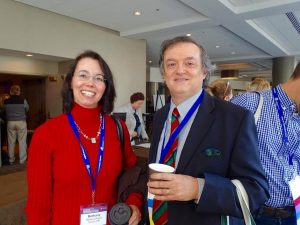Vedat Sar, MD, Committee Chair

Author and current Chair of the Scientific Committee Vedat Sar, MD, with fellow committee member Bethany Brand, PhD.
The ISSTD Scientific Committee was formed in 2012. The larger ISSTD Scientific Advisory Board was also formed to support the Scientific Committee during that same year. By way of some history – a precursor of this Committee was the former Internationalization Committee. Several members of this Committee joined the Scientific Committee or the Advisory Board. Some of them have subsequently been elected to the ISSTD Board. Hence, the efforts of these people and the Scientific Committee have served the long term ISSTD goal of becoming a truly international/global organization. The Scientific Committee is composed of 12 members (serving for three years) and one Chair (serving for five years). One of the members serves as Vice-Chair. Four memberships (seats) are renewed or replaced every year to provide equal opportunity for ISSTD members who wish to, and are capable of, contributing to scientific issues in the field. There are continuously live e-mail discussions among committee members about raising scientific questions in the trauma and dissociation field. Important published papers and ideas are shared. The high level of mutual learning and cross-fertilization are promising. Membership is international and composed of both clinicians and researchers. Usually, subgroups of the Committee work on projects which they are interested in (alongside advisory board members who join them for a particular Project). Several papers have been published throughout the last five years by the subgroups of the committee. A list of the papers is provided at the end of the article for those interested in reading further. Review and opinion papers remain the preference, however, empirical work is also desired. One group from the ISSTD Scientific Committee is in collaboration with the Scientific Committee of the European Society for Trauma and Dissociation (ESTD). Six or seven subprojects are ongoing. All of them are expected to arrive at scientific publication and one a publication in lay press. They are currently undergoing the review process. An important goal for the next five-year-term of the committee is to organize empirical studies with international collaboration. Given this background, the Scientific Committee aims at inclusion of colleagues who are interested in research in particular. The emerging generation of researchers are needed as they will carry these issues into the future of ISSTD. Research on complex trauma and dissociation has been recently generalized to the overall field of mental health. However, keeping the field focused on its spirit and remaining on track is closely linked to the survival of the field over the long run (i.e. “defending the knowledge”). This is why we need ISSTD and specific groups like the Scientific Committee and the Scientific Board. For those interested in joining the Committee: The main criterion of becoming a member of the Scientific Committee and the Scientific Board is being a clinician and /or researcher who publishes on trauma and dissociation extensively. Committee and Board membership occurs upon invitation, however, those ISSTD members who publish and do research, and want to be part of these committees, can apply to the Scientific Committee Chair.
Scientific Committee Papers Published
Şar V, Dorahy MJ, Krüger C. (2017). Revisiting the etiological aspects of dissociative identity disorder : a biopsychosocial perspective. Psychology Research and Behavioral Management, 10:137-146. Dorahy,M.J., Lewis-Fernández, R., Krüger, C. , Brand,B.L., Şar,V. ,Ewing, J. , Martínez-Taboas,A., Stavropoulos, P., Middleton,W. (2017). The role of clinical experience, diagnosis and theoretical orientation in the treatment of posttraumatic and dissociative disorders: a vignette and survey investigation. Journal of Trauma and Dissociation, 18(2):206-222. Brand B, Şar V, Korzekwa M, Kruger C, Martinez-Taboas A, Stavropoulos P, Middleton W (2016). Separating fact from fiction:an empirical examination of six myths about disociative identity disorder. Harvard Review of Psychiatry, 24(4):257-270. Middleton W, Stavropoulos P, Dorahy MJ, Krüger C, Fernandez-Lewis R, Martinez-Taboas A, Şar V, Brand B (2014): Child abuse and dynamics of silence. Australian and New Zealand Journal of Psychiatry 48(6): 581-583. Dorahy MJ, Brand BL, Şar V, Krüger C, Stavropoulos P, Martinez-Tabos A, Lewis-Fernandez R, Middleton W (2014): Dissociative identity disorder: An empirical overview. Australian and New Zealand Journal of Psychiatry 48(5):402-417. Middleton W, Stavropoulos P, Dorahy MJ, Krüger C, Fernandez-Lewis R, Martinez-Taboas A, Şar V, Brand B (2014): The Australian Royal Commission into institutional responses to child sexual abuse. Australian and New Zealand Journal of Psychiatry, 48(1), 17-21. Middleton W, Stavropoulos P, Dorahy MJ, Krüger C, Fernandez-Lewis R, Martinez-Taboas A, Şar V, Brand B (2014): The institutional abuse and societal silence: An emerging global problem. Australian and New Zealand Journal of Psychiatry, 48(1) :22-25. Şar V, Krüger C, Martinez-Taboas A, Middleton W, Dorahy M (2013): Sociocognitive and posttraumatic models of dissociation are not opposed. Journal of Nervous and Mental Disease, 201(5):439-440. Martinez-Taboas A, Dorahy M, Şar V, Middleton W, Krüger C (2013): Growing not dwindling: International research on the world-wide phenomenon of dissociative disorders. Journal of Nervous and Mental Disease, 201 (4):353-354. Şar V, Middleton W, Dorahy MJ (2012): The scientific status of childhood dissociative identity disorder: a review of published research. Psychotherapy &Psychosomatics, 81(3):181-184.


